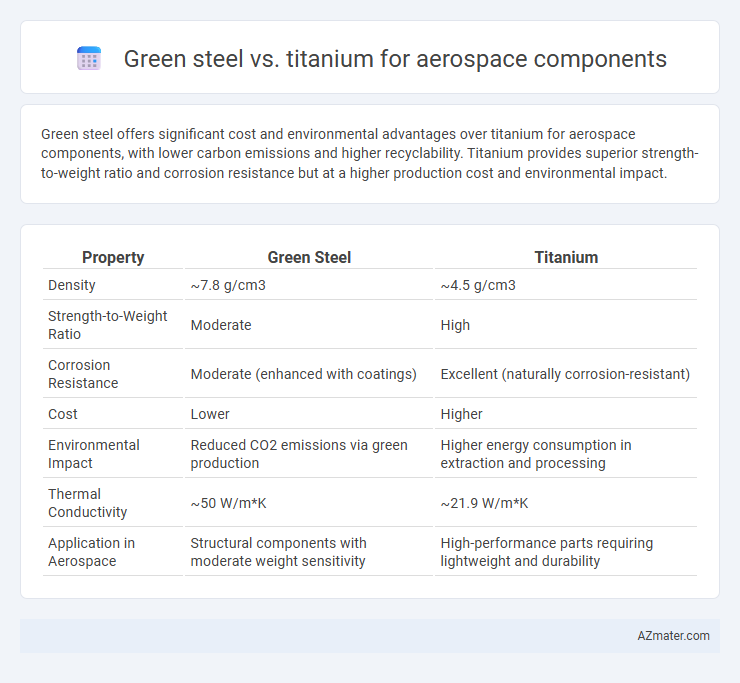Green steel offers significant cost and environmental advantages over titanium for aerospace components, with lower carbon emissions and higher recyclability. Titanium provides superior strength-to-weight ratio and corrosion resistance but at a higher production cost and environmental impact.
Table of Comparison
| Property | Green Steel | Titanium |
|---|---|---|
| Density | ~7.8 g/cm3 | ~4.5 g/cm3 |
| Strength-to-Weight Ratio | Moderate | High |
| Corrosion Resistance | Moderate (enhanced with coatings) | Excellent (naturally corrosion-resistant) |
| Cost | Lower | Higher |
| Environmental Impact | Reduced CO2 emissions via green production | Higher energy consumption in extraction and processing |
| Thermal Conductivity | ~50 W/m*K | ~21.9 W/m*K |
| Application in Aerospace | Structural components with moderate weight sensitivity | High-performance parts requiring lightweight and durability |
Introduction to Green Steel and Titanium in Aerospace
Green steel, produced using environmentally sustainable methods such as hydrogen reduction or electric arc furnacing, offers a lower carbon footprint alternative for aerospace components, enhancing industry efforts toward sustainability. Titanium, valued for its exceptional strength-to-weight ratio and corrosion resistance, remains a critical material in aerospace applications despite higher production energy demands. Comparing these materials highlights green steel's potential to reduce environmental impact while titanium continues to meet rigorous performance standards essential for aerospace engineering.
Material Properties Comparison: Strength, Weight, and Durability
Green steel offers impressive strength and sustainability advantages with a tensile strength typically ranging from 400 to 700 MPa, while titanium alloys exhibit superior strength-to-weight ratios, often exceeding 900 MPa. Titanium's low density of approximately 4.5 g/cm3 compared to green steel's higher density around 7.8 g/cm3 results in significantly lower component weight, critical for aerospace efficiency. Durability-wise, titanium provides exceptional corrosion resistance and fatigue life, whereas green steel, though more sustainable, may require additional treatments to match titanium's performance under extreme aerospace conditions.
Environmental Impact: Green Steel vs Titanium Production
Green steel production significantly reduces carbon emissions compared to traditional methods by utilizing hydrogen-based direct reduction and renewable energy sources, lowering the environmental footprint in aerospace manufacturing. Titanium production involves energy-intensive processes like the Kroll method, generating substantial greenhouse gases and chemical waste, posing greater environmental challenges. The adoption of green steel in aerospace components offers a more sustainable alternative by minimizing CO2 emissions and resource consumption over titanium extraction and refinement.
Cost Analysis for Aerospace Manufacturing
Green steel offers a cost-effective alternative to titanium in aerospace manufacturing due to lower raw material and production expenses, driven by sustainable steelmaking processes that reduce energy consumption. Titanium's high strength-to-weight ratio provides performance benefits but comes with significantly higher procurement and machining costs, impacting overall manufacturing budgets. Evaluating lifecycle costs, green steel's recyclability and reduced carbon footprint contribute to long-term economic advantages for aerospace component production.
Corrosion Resistance and Longevity
Green steel offers enhanced corrosion resistance through its eco-friendly production methods that result in fewer impurities and improved surface stability, making it suitable for aerospace components exposed to harsh environments. Titanium, renowned for its exceptional corrosion resistance due to a stable oxide layer, provides superior longevity in aerospace applications demanding lightweight and durable materials. While titanium excels in long-term performance and resistance to extreme conditions, green steel presents a cost-effective, sustainable alternative with competitive durability for aerospace structural components.
Sustainability and Recycling Potential
Green steel offers a sustainable alternative for aerospace components by significantly reducing carbon emissions during production through hydrogen-based direct reduction methods. Titanium, while prized for its strength-to-weight ratio and corrosion resistance, involves energy-intensive extraction processes that challenge its sustainability profile. Recycling green steel is more efficient and less energy-demanding compared to titanium, whose recycling is complicated by alloying elements, making green steel a preferred choice for eco-conscious aerospace manufacturing.
Performance in Extreme Aerospace Environments
Green steel offers excellent strength-to-weight ratio and corrosion resistance, making it suitable for aerospace components exposed to harsh environments. Titanium outperforms green steel with superior temperature tolerance, fatigue resistance, and a lighter weight, critical for extreme aerospace conditions. Advanced titanium alloys deliver unmatched durability and resistance to thermal expansion, ensuring optimal performance in high-stress aerospace applications.
Machinability and Fabrication Challenges
Green steel offers improved machinability due to its lower hardness and well-controlled microstructure, making it easier to cut and shape compared to titanium, which is characterized by high strength-to-weight ratio but presents significant challenges in tooling wear and heat generation during machining. Titanium's tendency to gall and its low thermal conductivity require specialized cutting tools and cooling techniques, increasing fabrication complexity and costs in aerospace components. The fabrication of green steel benefits from conventional machining practices and lower energy consumption, making it a more cost-effective and sustainable choice despite titanium's superior corrosion resistance and performance in extreme environments.
Regulatory Standards and Certification for Aerospace Materials
Green steel and titanium are both subject to stringent regulatory standards and certification processes critical for aerospace components, with titanium dominating due to its established track record in airworthiness and compliance with FAA and EASA standards. Green steel, emerging as a sustainable alternative, must meet evolving aerospace material certifications such as AMS (Aerospace Material Specifications) and NADCAP (National Aerospace and Defense Contractors Accreditation Program) requirements for strength, corrosion resistance, and fatigue performance. Regulatory frameworks emphasize traceability, testing protocols, and environmental impact assessments, positioning titanium as the current standard while green steel undergoes ongoing validation to achieve equivalent aerospace material certification and reliability.
Future Trends: Innovations in Aerospace Materials
Green steel, produced through low-carbon processes, is gaining attention for sustainable aerospace components due to its reduced environmental impact and promising strength-to-weight ratio. Titanium remains dominant for aerospace applications because of its superior corrosion resistance, high strength, and excellent fatigue performance at elevated temperatures. Future trends indicate hybrid material systems combining green steel's sustainability with titanium alloys' performance, alongside advancements in additive manufacturing and surface treatments to enhance component efficiency and longevity.

Infographic: Green steel vs Titanium for Aerospace component
 azmater.com
azmater.com